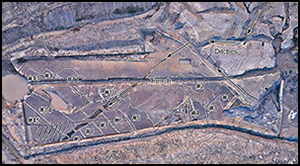Crossref Citations
This article has been cited by the following publications. This list is generated based on data provided by
Crossref.
Zhuang, Yijie
Lee, Heejin
and
Kidder, Tristram R.
2016.
The cradle of heaven-human induction idealism: agricultural intensification, environmental consequences and social responses in Han China and Three-Kingdoms Korea.
World Archaeology,
Vol. 48,
Issue. 4,
p.
563.
Kim, Minkoo
Shin, Heung-Nam
Kim, Jinhee
Roh, Kyeong-jung
Ryu, Ara
Won, Haesun
Kim, Juho
Oh, Semi
Noh, Hyeongsin
and
Kim, Sumin
2016.
The ins and the outs: Foodways, feasts, and social differentiation in the Baekje Kingdom, Korea.
Journal of Anthropological Archaeology,
Vol. 43,
Issue. ,
p.
128.
Lee, H.
and
French, C.
2016.
Detecting long-term valley fill evolution and rice paddy land use: Ageoarcheological investigation of the Baeksuk valley and the Bronze Age settlement, South Korea.
CATENA,
Vol. 142,
Issue. ,
p.
190.
Kwak, Seungki
Kim, Gyeongtaek
and
Lee, Gyoung-Ah
2017.
Beyond rice farming: Evidence from central Korea reveals wide resource utilization in the Songgukri culture during the late-Holocene.
The Holocene,
Vol. 27,
Issue. 8,
p.
1092.
Kim, Minkoo
Oh, Ranyeong
Bang, Moonbae
Rha, Jeong-Wook
and
Jeong, Youjin
2018.
Rice and Social Differentiation on a Volcanic Island: An Archaeobotanical Investigation of Yerae-dong, Korea.
Cambridge Archaeological Journal,
Vol. 28,
Issue. 3,
p.
475.
Twiss, Katheryn C.
2019.
The Archaeology of Food.
Qin, Ling
and
Fuller, Dorian Q.
2019.
Prehistoric Maritime Cultures and Seafaring in East Asia.
Vol. 1,
Issue. ,
p.
159.
Leipe, Christian
Kuramochi, Shunsuke
Wagner, Mayke
and
Tarasov, Pavel E.
2020.
Ritual practices and social organisation at the Middle Yayoi culture settlement site of Maenakanishi, eastern Japan.
Archaeological and Anthropological Sciences,
Vol. 12,
Issue. 7,
Kim, Habeom
Bone, Christopher
and
Lee, Gyoung-Ah
2020.
Landscapes shared by visibility: a case study on the settlement relationships of the Songgukri culture, Korea.
Archaeological and Anthropological Sciences,
Vol. 12,
Issue. 2,
Li, Brian
and
Kim, Minkoo
2021.
Cultivation of Perilla frutescens (Lamiaceae) in prehistoric Korea.
Journal of Archaeological Science: Reports,
Vol. 40,
Issue. ,
p.
103224.
Choy, Kyungcheol
Yun, Hee Young
Lee, Jungchul
Fuller, Benjamin T.
and
Shin, Kyung-Hoon
2021.
Direct isotopic evidence for human millet consumption in the Middle Mumun period: Implication and importance of millets in early agriculture on the Korean Peninsula.
Journal of Archaeological Science,
Vol. 129,
Issue. ,
p.
105372.
Jeong, O-Young
Park, Hyeon-Su
Baek, Man-Kee
Kim, Woo-Jae
Lee, Geon-Mi
Lee, Chang-Min
Bombay, Maurene
Ancheta, Melanie Banzon
and
Lee, Jeom-Ho
2021.
Review of rice in Korea: current status, future prospects, and comparisons with rice in other countries.
Journal of Crop Science and Biotechnology,
Vol. 24,
Issue. 1,
p.
1.
Lee, Hyunsoo
Kim, Younghun
and
Lee, Gyoung-Ah
2023.
Niche Construction of Ban-nong ban-eoh in Southwestern Korea: Archaeobotanical Data from the Early Iron to Three Kingdoms Periods.
Journal of Field Archaeology,
Vol. 48,
Issue. 6,
p.
415.
Kim, Minkoo
Lee, Jinwoo
Hyung, Yoojin
Shin, Hayeong
Kim, Sunwook
and
Chae, Subin
2023.
Paddy rice, aggregation, and the development of Mumun social organization in Ulsan, southeastern Korea.
Archaeological Research in Asia,
Vol. 34,
Issue. ,
p.
100447.
Kumar, Vikash
Yadav, Mohini
Awala, Simon Kamwele
Valombola, Johanna Shekupe
Saxena, Maneesha S.
Ahmad, Faheem
and
Saxena, Saurabh C.
2024.
Millets: a nutritional powerhouse for ensuring food security.
Planta,
Vol. 260,
Issue. 4,
Oh, Gyujin
Wi, Yunju
Kang, Hee-Jin
Cheon, Seung-ju
Sung, Ha-Cheol
Kim, Yena
and
Jin, Hong-Sung
2024.
Assessment of American Bullfrog (Lithobates catesbeianus) spreading in the Republic of Korea using rule learning of elementary cellular automata.
Scientific Reports,
Vol. 14,
Issue. 1,
Pelloli, Claudio
2024.
The long rice story. A comparison of rice’s introduction into Italy and Japan.
Asian Archaeology,
Vol. 8,
Issue. 1,
p.
37.
Choy, Kyungcheol
Yun, Hee Young
Fuller, Benjamin T.
Mannino, Marcello A.
and
Hart, John P.
2024.
Enhanced dietary reconstruction of Korean prehistoric populations by combining δ13C and δ15N amino acids of bone collagen.
PLOS ONE,
Vol. 19,
Issue. 3,
p.
e0300068.
